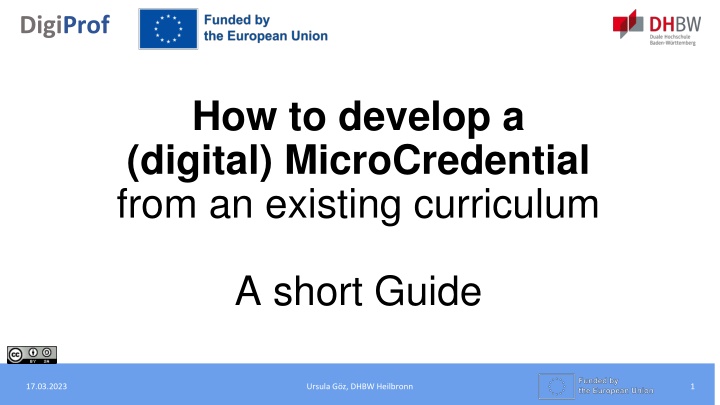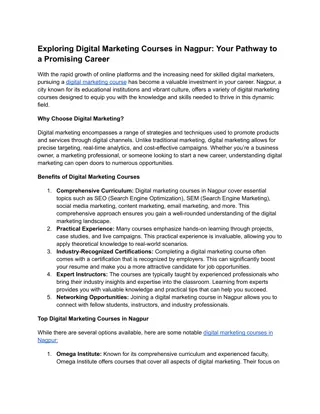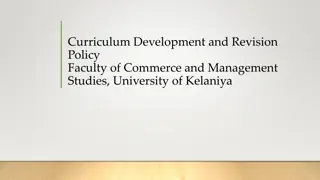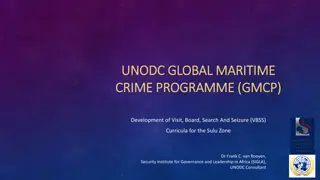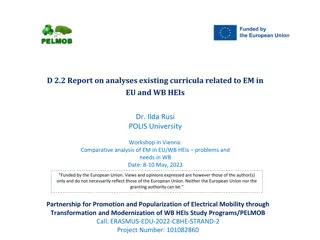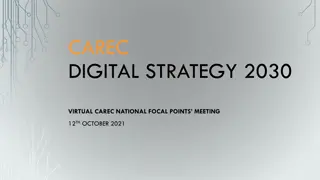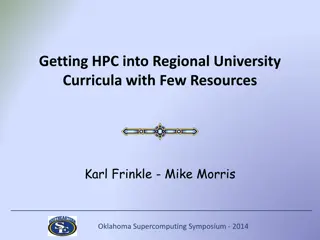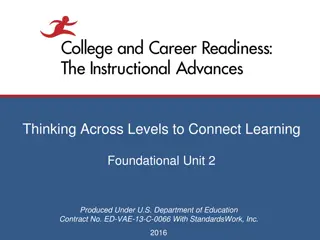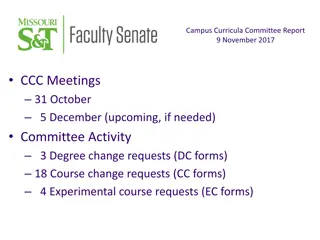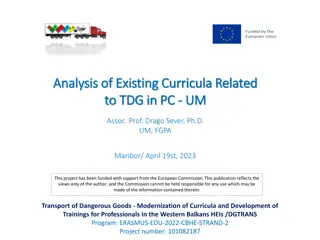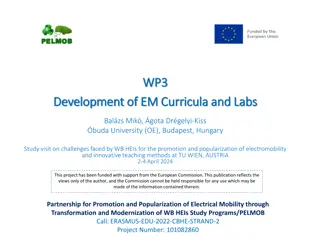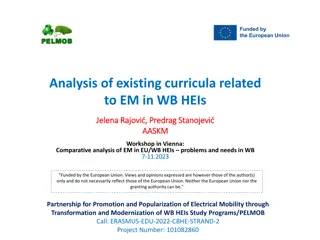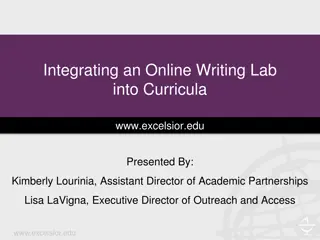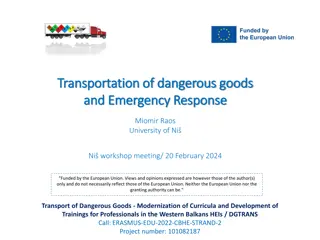Guide to Developing Digital MicroCredentials from Existing Curricula
Explore the process of transforming existing curricula into focused MicroCredentials to enhance learning experiences in Higher Education. Learn how to analyze, select, design, and describe learning outcomes effectively. Utilize online teaching pedagogies and professional expertise to create a valuable learning pathway for students.
Download Presentation

Please find below an Image/Link to download the presentation.
The content on the website is provided AS IS for your information and personal use only. It may not be sold, licensed, or shared on other websites without obtaining consent from the author.If you encounter any issues during the download, it is possible that the publisher has removed the file from their server.
You are allowed to download the files provided on this website for personal or commercial use, subject to the condition that they are used lawfully. All files are the property of their respective owners.
The content on the website is provided AS IS for your information and personal use only. It may not be sold, licensed, or shared on other websites without obtaining consent from the author.
E N D
Presentation Transcript
DigiProf How to develop a (digital) MicroCredential from an existing curriculum A short Guide 17.03.2023 Ursula G z, DHBW Heilbronn 1
DigiProf The usefulness of a MicroCredential (MC) is closely related to the careful extraction of feasible subject areas for constituting a small learning unit. Keeping in mind the idea of a learner-centered approach, this guideline may help professional teachers in Higher Education in designing the content of a MicroCredential. The aim is to grant the learner a positive experience in a relevant competence area focusing on an enclosed topic. Introduction 17.03.2023 Ursula G z, DHBW Heilbronn 2
DigiProf Analyse Complete Data Select Describe Learning Outcome Celebrate [Re-] Design [Iterate] Collect Feedback Arrange Pilot Create Process Overview Describe Assessment Combine 17.03.2023 Ursula G z, DHBW Heilbronn 3
DigiProf Analyse Select Describe Learning Outcome [Re-] Design STEP 1 Analyse curricula and existing modules as well as student cohorts in selected, accredited BA courses. Online learning requires self-discipline and suitable self-organisation, therefore focus on advanced students. Arrange Create Describe Assessment Combine 1. Analyse 17.03.2023 Ursula G z, DHBW Heilbronn 4
DigiProf STEP 2 Select one topic according to the following criteria: Analyse ? it will create a reasonable and useful learning experience for the target group of students ? it presents a self-contained learning experience Select Describe Learning Outcome [Re-] Design ? the acquisition of knowledge and competences for this topic should be enabled through online-teaching pedagogies ? students' workload to learn about the topic should comply with the envisaged number of hours (incl. assessment tasks), respectively the adequate planned amount of ECTS. Arrange Create Combine Use your professional and subject experience for determining the scope of the MicroCredential (MC). Consider that different, related, single topics finally could be combined for making up a Short Learning Program (SLP) by pooling several MCs. 2. Select 17.03.2023 Ursula G z, DHBW Heilbronn 5
DigiProf Analyse Select Describe Learning Outcome [Re-] Design STEP 3 Arrange Describe learning outcomes and competences for the new learning unit and map them with ESCO or other competence frameworks. Create Combine See more in ANNEX I. 3. Describe Learning Outcomes 17.03.2023 Ursula G z, DHBW Heilbronn 6
DigiProf STEP 4 Analyse Select [Re-] Design and outline a teaching and learning scenario according to requirements of self-contained units for digital use, reflecting on how to ensure, enable and encourage: Describe Learning Outcome [Re-] Design ? competence- based and self- regulated learning ? interaction between the content and learners Arrange ? virtual collaboration among learners ? reflection and critical thinking Create Combine 4. [Re]-Design 17.03.2023 Ursula G z, DHBW Heilbronn 7
DigiProf STEP 5 Arrange and align appropriate elements of teaching and learning, involving students where possible, e.g. Analyse Select Describe Learning Outcome supporting scripts PDF files for download videos or podcasts [Re-] Design OER to be integrated (e.g. YouTube, tutorials, e-books, papers, ) collaborative tasks Arrange assignments Constructive Alignment (after Biggs & Tang, 2010) Create (self-) assessment tasks (e.g. quizzes, short essays, peer assessment, pitches, take home or open book exams, case studies) Combine according to the principle of Constructive Alignment. 5. Arrange 17.03.2023 Ursula G z, DHBW Heilbronn 8
DigiProf Analyse SelectDescrib e Learnin g Outco me [Re-] Design STEP 6 Create digital learning materials consistently, using existing tools, infrastructure and available platforms for design, distribution and process management. Arrang e Consider inclusiveness and accessibility. Create Combin e Focus on effective, efficient and appealing learning materials. 6. Create 17.03.2023 Ursula G z, DHBW Heilbronn 9
DigiProf Analyse Select Describe Learning Outcome STEP 7 [Re-] Design Combine elements to form a MicroCredential, Arrange Then check if assessment tasks match the learning outcomes adequately and calculate the workload for the learners. Create Describe Assessmen Don t forget setting a distinctive name or headline for the course. Combine 7. Combine 17.03.2023 Ursula G z, DHBW Heilbronn 10
DigiProf Analyse Complete Data Select Describe Learning Outcome Celebrate [Iterate] [Re-] Design STEP 8 Describe assessment topic, requirements, type/format and method, supervision and identity verification, as well as grading criteria according to the ECCOE Model of Digital Credentials, Collect Feedback Arrange See template ANNEX II. Pilot Create Describe Assessment Combine 8. Describe Assessment 17.03.2023 Ursula G z, DHBW Heilbronn 11
DigiProf Analyse Complete Data Select Describe Learning Outcome Celebrate [Iterate] [Re-] Design STEP 9 Pilot the whole material sequence of the planned MicroCredential, if possible, in your institution. Collect Feedback Arrange Prepare the students accordingly. Pilot Create Describe Assessment Combine 9. Pilot 17.03.2023 Ursula G z, DHBW Heilbronn 12
DigiProf Analyse Complete Data Select Describe Learning Outcome Celebrate [Iterate] [Re-] Design STEP 10 Collect feedback from stakeholders (students, other educators, faculty, learning support dept., ) and adapt single parts of the MicroCredential-course, or re-arrange the whole setting. Collect Feedback Arrange Pilot Create Describe Assessment Combine 10. Collect Feedback 17.03.2023 Ursula G z, DHBW Heilbronn 13
DigiProf Analyse Complete Data Select Describe Learning Outcome Celebrate [Iterate] [Re-] Design STEP 11 Collect Feedback Arrange If needed, repeat steps 5. to 10. Pilot Create Describe Assessment Combine 11. Iterate 17.03.2023 Ursula G z, DHBW Heilbronn 14
DigiProf Analyse Complete Data Select Describe Learning Outcome Celebrate [Iterate] [Re-] Design STEP 12 Celebrate the successful process and achievement! A new MicroCredential is born! Collect Feedback Arrange Pilot Create Describe Assessment Combine 12. Celebrate 17.03.2023 Ursula G z, DHBW Heilbronn 15
DigiProf Analyse Complete Data Select STEP 13 Complete institutional data, credential data, curriculum characteristics etc. to suit the ECCOE Model of Digital Credentials. Describe Learning Outcome Celebrate See template in ANNEX II. [Iterate] [Re-] Design If approved by your institutional processes, the MicroCredential (MC) can be part of your institution s Learning Opportunity Catalogue. Issuing the MC as a certificate should be enabled for those who proved the achievement of the MC learning outcomes by an appropriate assessment. Specific learners data need to be added. Recognition by other HE providers in the EU will be facilitated. Collect Feedback Arrange Pilot Create Describe Assessment Combine See example ANNEX III. 13. Complete 17.03.2023 Ursula G z, DHBW Heilbronn 16
DigiProf STEP 14 (optional) Integrate the new MicroCredential into the formal curriculum of your institution or - due to the feature of stackability - to form a Short Learning Programme comprising several MicroCredentials. 14. Integrate 17.03.2023 Ursula G z, DHBW Heilbronn 17
DigiProf Please check out: ANNEX I_ECCOE_How to link learning outcomes to ESCO.pdf ANNEX II_ECCOE Model-Digital-Credential-v4 from .xls_.pdf ANNEX III_ECCOE_MicroCredential-Module_description.docx ANNEX 17.03.2023 Ursula G z, DHBW Heilbronn 18
DigiProf Biggs, J., & Tang, C. (2010, February). Applying constructive alignment to outcomes-based teaching and learning. In Training material for quality teaching for learning in higher education workshop for master trainers, Ministry of Higher Education, Kuala Lumpur (Vol. 53, No. 9, pp. 23-25). https://web.archive.org/web/20170918084111id_/http://drjj.uitm.edu.my:80/DRJJ/MQAGGPAS-Apr2011/What- is-CA-biggs-tang.pdf EU Commission. ESCO Skills and Competences. https://esco.ec.europa.eu/en/classification/skill_main ECCOE Erasmus+ project: https://eccoe.eu/ particularly https://eccoe.eu/outputs/io1/ and https://eccoe.eu/wpcontent/uploads/sites/28/2022/09/ECCOE_IO5 _How_to_guides_Public_Report_20220731_en.pdf REFERENCES 17.03.2023 Ursula G z, DHBW Heilbronn 19
DigiProf Please contact us for further ideas, questions or remarks on this training material ursula.goez@heilbronn.dhbw.de Training material "Ensuring digital and micro-credentialization of learning as a part of transparent assessment for recognition of learning outcomes" by G z U., Cepauskiene R., is licensed under a Creative Commons Attribution- ShareAlike 4.0 International License 20
